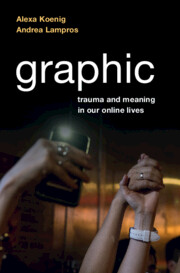Book contents
- Graphic
- Graphic
- Copyright page
- Epigraph
- Contents
- Figures
- Foreword
- Acknowledgments
- Interviewees
- Introduction
- 1 A Short Summary of a Long History of Graphic Witnessing
- 2 Images and Our Bodies
- 3 Images and Identity
- 4 Agency and Control
- 5 Community as a Protective Force
- 6 Meaning in Our Online Lives
- 7 Policy and Practice
- Afterword
- Note on Images, Identity, and Social Justice
- Suggested Reading
Introduction
Taking in Trauma from Our Newsfeed
Published online by Cambridge University Press: 31 August 2023
- Graphic
- Graphic
- Copyright page
- Epigraph
- Contents
- Figures
- Foreword
- Acknowledgments
- Interviewees
- Introduction
- 1 A Short Summary of a Long History of Graphic Witnessing
- 2 Images and Our Bodies
- 3 Images and Identity
- 4 Agency and Control
- 5 Community as a Protective Force
- 6 Meaning in Our Online Lives
- 7 Policy and Practice
- Afterword
- Note on Images, Identity, and Social Justice
- Suggested Reading
Summary
This introduction to the book Graphic provides a brief overview of today’s digital information and media landscape, underscoring the often graphic nature of online content. Introducing the subject matter through the lens of a journalist who worked on the New York Times’ analysis of George Floyd’s killing, the authors raise the psychosocial risks that can come with engaging with upsetting online content, including secondary or vicarious trauma. Laying out a brief history of the role of visual imagery in advancing social change, they also emphasize the importance of finding ways to stay informed about the major social issues depicted in such imagery. Finally, this chapter provides an overview of the topics addressed in Graphic, ranging from the history of graphic visual content and its impact on human and civil rights, to how images affect people biologically and psychologically, to the ways peoples’ individual identities intersect with their experiences in potentially protective and harmful ways, to how people can increase their agency over their engagement with social media in order to minimize harm, to the ways community can act as a protective force, to strategies for maximizing meaning and other positive experiences from online experiences.
Keywords
- Type
- Chapter
- Information
- GraphicTrauma and Meaning in Our Online Lives, pp. 1 - 17Publisher: Cambridge University PressPrint publication year: 2023



